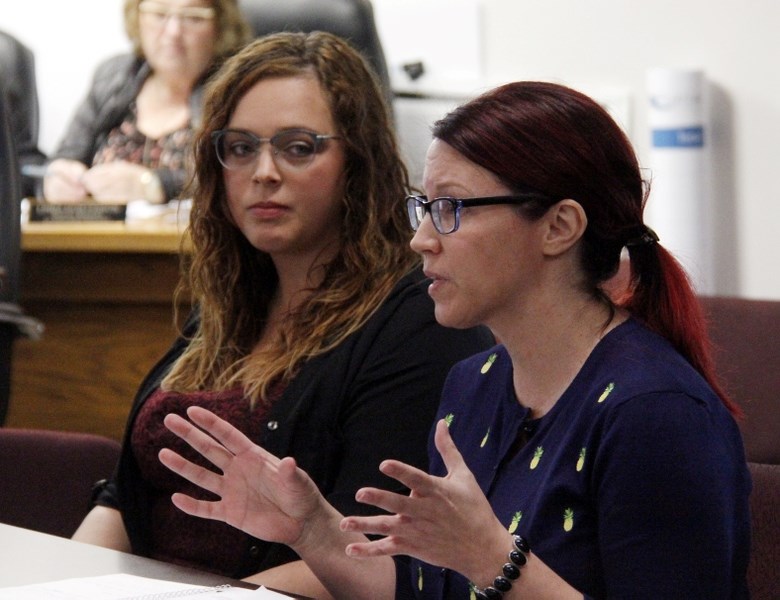The Lakeland Humane Society (LHS) continues to see an increase in the cost of doing business, as the price of caring for animals coming in continues to climb.
Kyla Hunter, shelter manager for LHS, pitched their 2018 budget to the City of Cold Lake council, during their regular meeting on Tuesday, Oct. 24.
Over the years, the city has provided funding to the local animal shelter, in return for their services.
“The humane society provides the pound keeping services for the City of Cold Lake, which has quite a lot of stray animals that run at large. As the years have gone by, the animals have been coming in worse shape,” Hunter expressed. “We have an opening mission contract with the city, meaning no matter how full we get, we take all of the strays that are running at large so there is never a public safety risk.”
For every 10 animals brought into the humane society either by bylaw enforcement officers, RCMP, or a resident of Cold Lake, six require additional treatment.
“After they come in, the animals undergo a quarantine period. If they didn't, disease could get out of control,” explained Hunter. “During that time, they receive any medical attention that they need. They're then moved into our adoption program.”
Last year, LHS cared for 526 animals, a slight drop from the year prior, where they saw 544 animals come into the shelter.
In 2016, the LHS was home to 514 animals impounded from within the limits of the city, 256 were cats, 257 were dogs, and one goat.
“The average stay in the shelter for dogs is 78 days, and for cats, it's 141 days,” Hunter said.
Hunter admitted their claim rate could be better, with only 18 per cent of cats being returned to their homes, and 37 per cent of dogs.
For this year, the city has provided just over $163,000 in funding for the 2017 contract.
The shelter is hoping to see that number increase by 32 per cent for 2018, in order to meet the high cost of doing business.
“The cost of providing care for strays has risen exponentially,” said Hunter. “In 2016, the cost of caring for the 414 animals impounded in Cold Lake was $380,606. On average, the cost breaks down to $740 per animal.”
The LHS is looking for $217,020 in financial support for next year. This funding would be paid in 12-monthly installments of $18,085.
The following year, the LHS would like to see that number increase again to $227,871, and continue on that trend until 2022, when the support would reach just shy of $250,000.
In total, 24 per cent of the LHS revenue comes from fundraising, 15 per cent from donations, and 20 per cent from the animal care centre.
“That means our adoption fees, our microchipping fees, giving baths, nail trims, and those types of things,” explained Hunter.
Grant funding equates for seven per cent of their revenue, while one per cent comes from memberships, two per cent from administration, and 31 per cent from the City of Cold Lake contract, licensing fees, and claiming fees.
“The most important thing for the LHS is to remain sustainable in the long-term, and to be able to continue to provide the pound keeping services,” added Hunter.
Their costs are rising because of the increase to minimum wage, maintenance costs, heating and other utilities, vet care, and shelter supplies.
“We are very fiscally responsible. We get a lot of donations, not just money, but also things like laundry detergent, dish soap, towels, bedding, pet food, everything that can get donated, is donated,” Hunter noted.
Currently, LHS has a contract with Pierceland, SK, similar to the City of Cold Lake, however, the area only brings in a handful of animals a year.
At one point in time, they also had a contract with the MD of Bonnyville, which brought in about $6,000 and a dozen animals per year. It was put to an end because of the shelter's size.
Hunter described how they are caring for over 92 cats, even though they only have 22 cat kennels.
“It's the demographics in this area. They're difficult to work with because there are so many communities very close to the borders of Cold Lake that don't have animal control,” Hunter explained.
Coun. Bob Buckle wondered if the transient population are leaving their pets at the shelter, rather than paying the $40 impound fee to pick them up.
“I'm not surprised by the numbers you bring in, and I'm not surprised by our low reclaim rate. I do wonder whether there is a better way of impounding, whether it's a smaller fee or another way. I do think the transient community pack up and leave, and they can't take their animal with them. That becomes a bit of a problem,” he said.
Council agreed to discuss the increase to their funding to LHS during budget deliberations in November.



